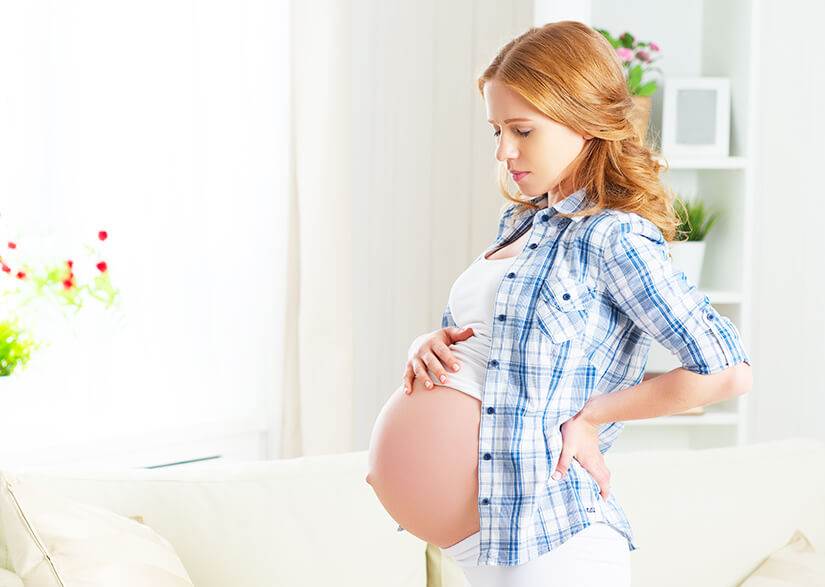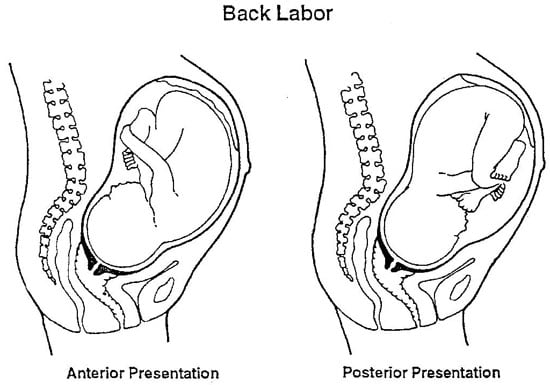
But as labor approaches, it can actually be a real pain in the back!
Read on to find out more about back labor and how you can ease the discomfort.
What is back labor?
When experiencing contractions, many women expect to feel pain in their uterus during labor. In fact, it’s quite possible to feel intense pain in the lower back when giving birth.
This is referred to as back labor, and it may be felt both during and even in between contractions.
Unfortunately, back labor can be extremely unpleasant, much more so than regular labor pains, and most women who experience it will opt for an epidural to help deal with the pain. Let’s just say it’s no fun at all.
What causes back labor?
The agreed-upon cause of back labor is the position of the baby in the mother’s womb.
If the baby lies in the occiput posterior presentation (where he is facing the mother’s abdomen) it means that the harder part of the baby’s skull may rest on the lower part of mom’s spine (the tailbone) causing pain.
Sometimes this is referred to the baby being ‘sunny side up!’

Towards the end of my own pregnancy, my midwife believed that my baby boy was in the O.P position and advised me of different ways to try and alter his position.
I had been told that my labor could be more painful if he were to stay in that position, so I was willing to give anything a try!
What might convince baby to turn?
To help baby turn to an Anterior Presentation (where baby looks towards mom’s back), I was advised to try a few things:
- Sitting upright in a hard-backed chair rather than lounging back on a sofa.
- Only lying on my left-hand side in bed.
- Having a cushion to sit on when driving, to prevent my hips tilting back.
- Leaning forward over a birth ball.
I was even told of an old wives’ tale where women were advised to scrub the kitchen floor on their hands and knees! Apparently all that time spent on all fours could help the baby turn via the wonders of gravity!
I can’t say I tried or recommend this method, though!
Other techniques you could try include:
- Walking
- Pelvic tilts and hula-hoop dancing
- Squatting and lunging
- Sitting on a birth ball.
(It’s worth checking the timing of the last two with your midwife, as they both have the ability to help baby engage in the birth canal. We don’t want to encourage baby to engage if he’s not yet in the best position!)
If you’d like to read more on changing baby’s position in the womb, Spinning Babies is a great site to look at.
Another theory…
Another theory behind the cause of back labor is that the pain is “referred” to your lower back from your uterus during labor.
This theory is backed up (if you’ll pardon the pun!) by the fact that it is common for women to experience back ache during their period. This back pain obviously can’t be blamed on baby’s head!
Who is more likely to experience back labor?
According to WhatToExpect:
- Overdue moms (over 40 weeks gestation) may possibly be more likely to experience back labor.
- Having a BMI of 29 or more, or being a first-time mommy may heighten the chances of having a baby in the ‘sunny side up’ position.
- This position can also be more likely during labors which have been induced or where a woman’s waters have been broken artificially.
My midwife suggested that babies are more commonly found in this position nowadays due to our lifestyle.
Sitting in cars for extended periods or on the sofa (rather than at a table) may also cause baby to flop backwards into this position.
What does research say?
Despite what I was advised about getting baby to dance his way around my uterus, research suggests that baby’s position perhaps isn’t a cause of back labor.
In a 2005 study of 700 women whose babies were in the Occiput Posterior position, it was found that these moms-to-be were no more likely to suffer back labor than those whose little bundles were in other positions.
Whether or not baby’s position is the true cause, back pain really is a pain!
So what can you do about it?
How to make the back pain easier to deal with.
Counter Pressure
Have your partner, a friend or family member push just above the sacrum (tailbone). A warm pad or cold pack may also help- use whatever works for you!
Pelvic Tilts
These can be used before labor to correct baby’s position, or also during labor to help ease the pain. Find a guide to this gentle exercise here.
Water
Sitting in a tub of warm water can really ease the pain of labor.
As much as my little one had moved back to a more favourable position by the time he began to make his entrance into the world, a soothing bath at home (followed by a water birth at the hospital) certainly helped! Just make sure the water is of a suitable temperature for pregnancy.
TENS (Transcutaneous Electrical Nerve Stimulation) machines are also a way to ease labor pain. Short and low electrical pulses help manage the pain and are best used early on in labor.
What about momma’s position?
If baby’s position may be causing the issue, then mom’s position can certainly help!
Try laboring on your hands and knees. This tips the baby slightly out of the pelvis, creating more spare for movement and rotation. This position also allows someone to apply counter pressure to your lower back.
Ami Burns, a doula, recommends sitting on a birth ball with your legs wide open. This squatting position also allows room for baby to rotate.
The birth ball is my favorite tool, and not just as a doula. I used a birth ball during labor with both of my own kids, and I credit it with helping labor progress as well as with relieving my aching back.
Many hospitals will have these available, or else you can provide your own.
Forget the movies!
Forget all the movie and TV show scenes you’ve seen where women lie screeching on their backs with legs akimbo!
Although there may be times when your doctor or midwife require this for monitoring or intervention purposes, it’s actually a much more painful way to labor! (Speaking from experience!)
Find more about active laboring positions which could ease your pain here.
Is it labor?
If you’ve suffered from back pain throughout your pregnancy, you may be wondering how you’ll know that this is the real deal and that baby is on the way!
Chances are you’ll definitely know! But check out these other signs of labor here if you’d like to be sure.
SOURCE: Momtricks












Post a Comment